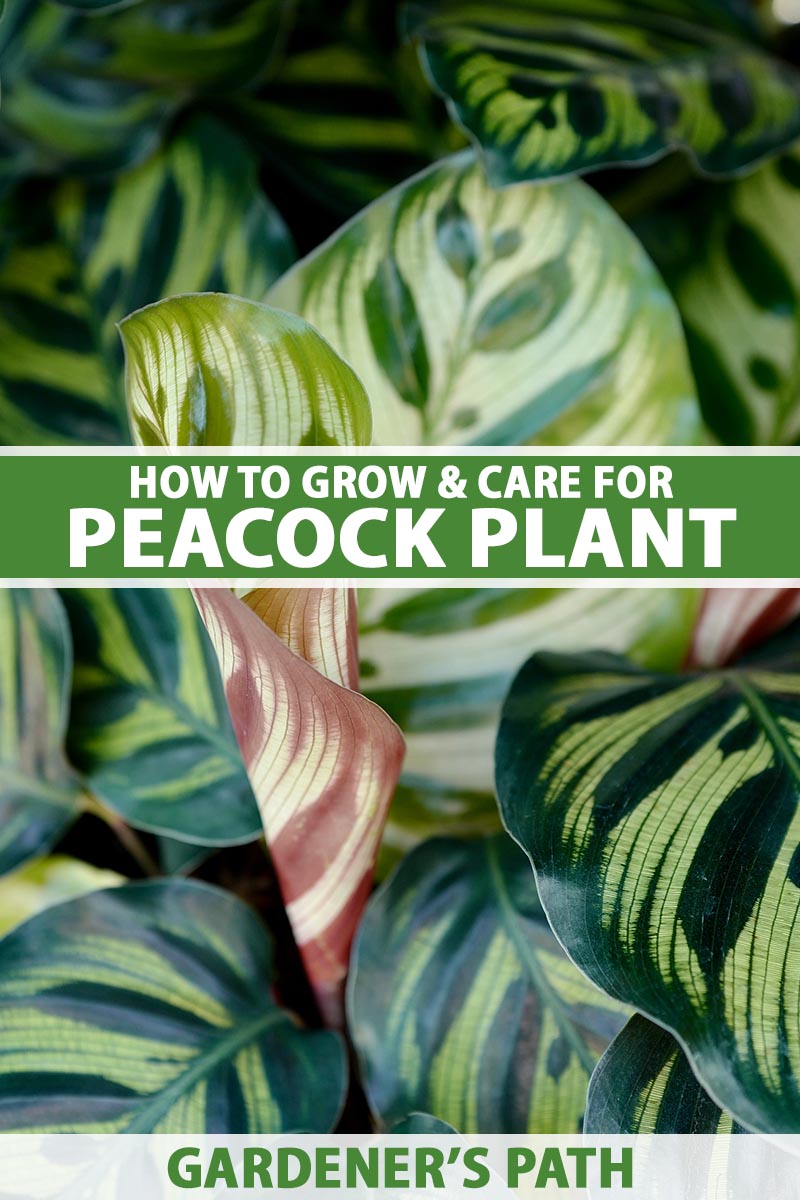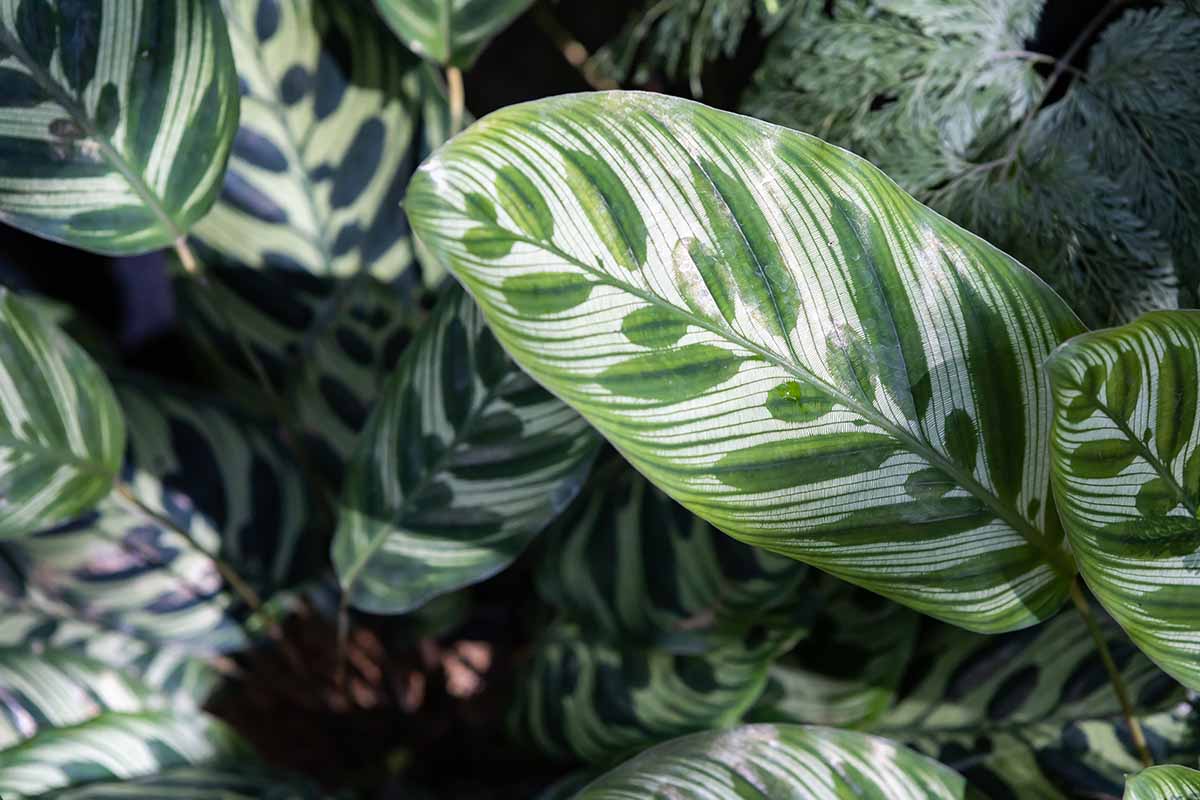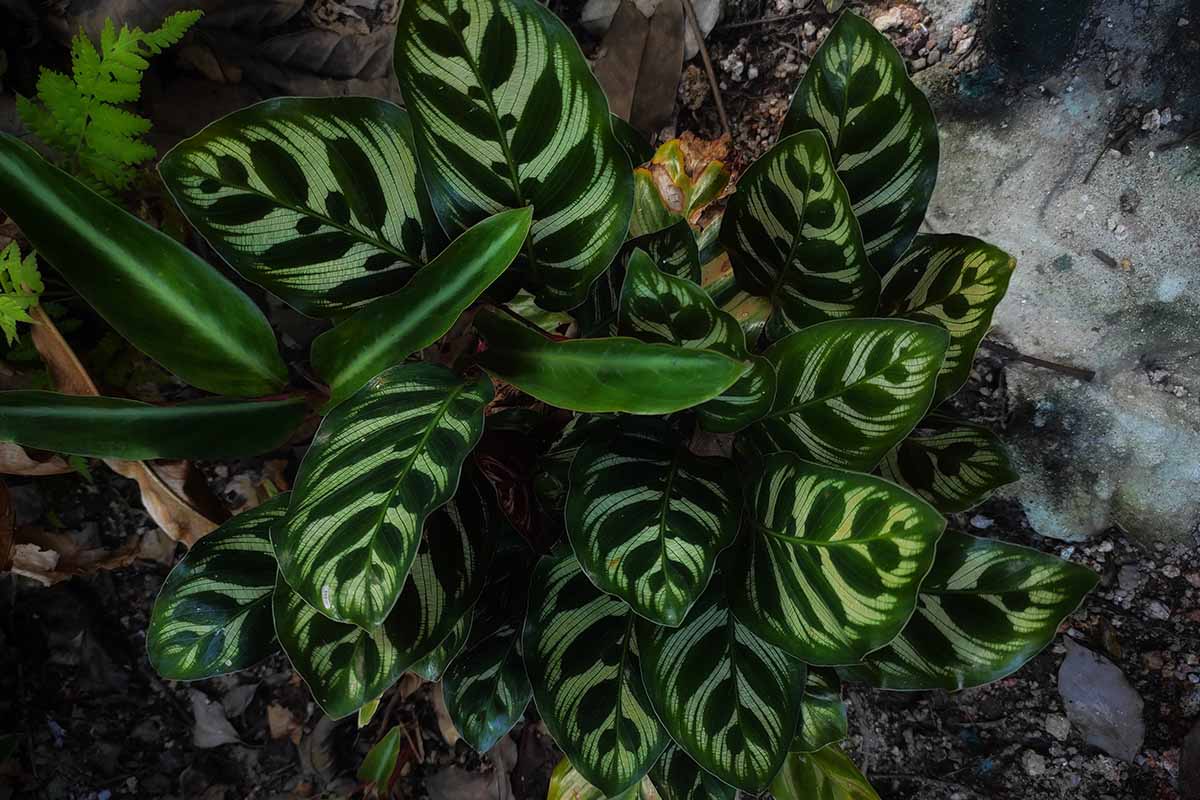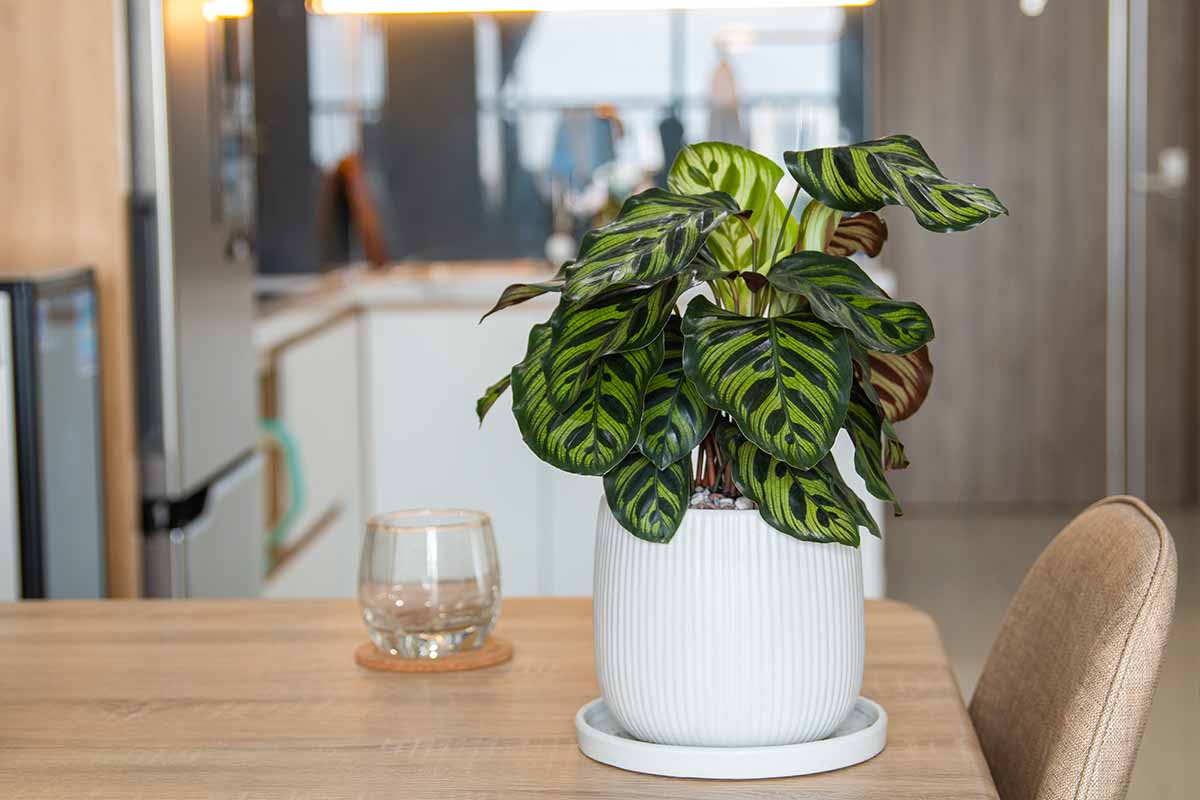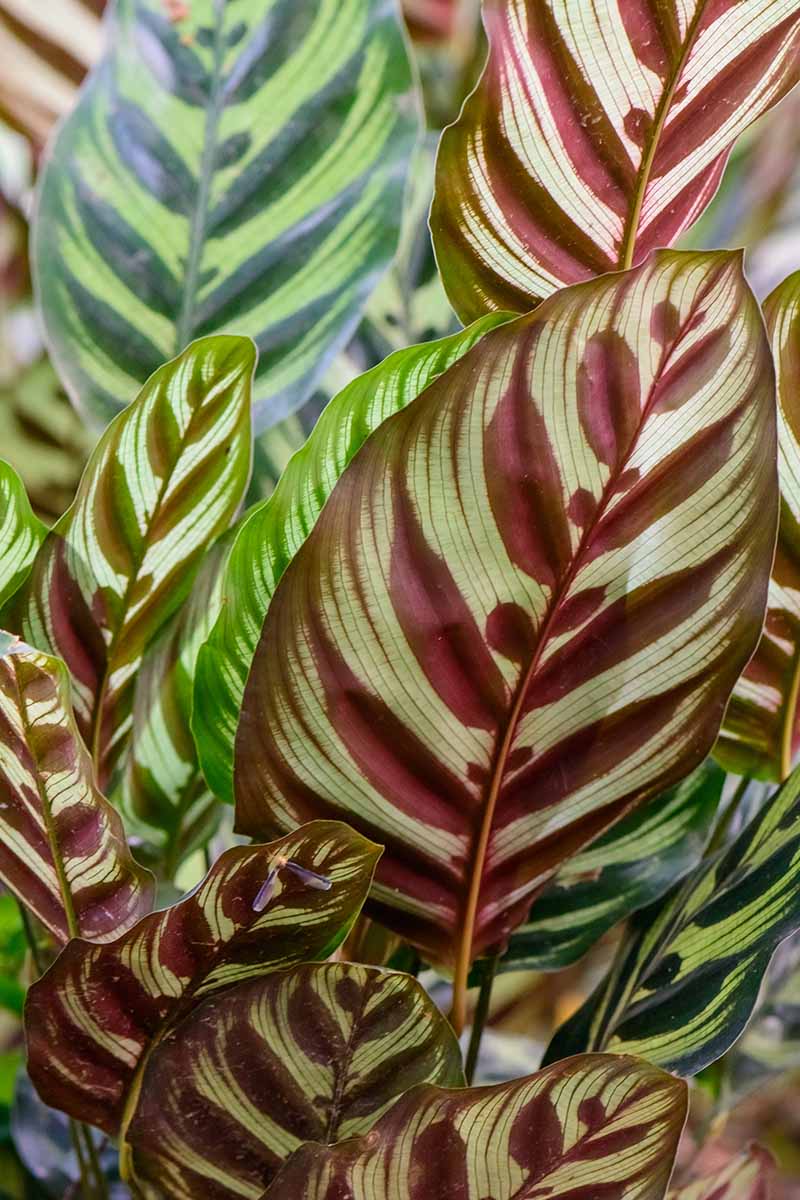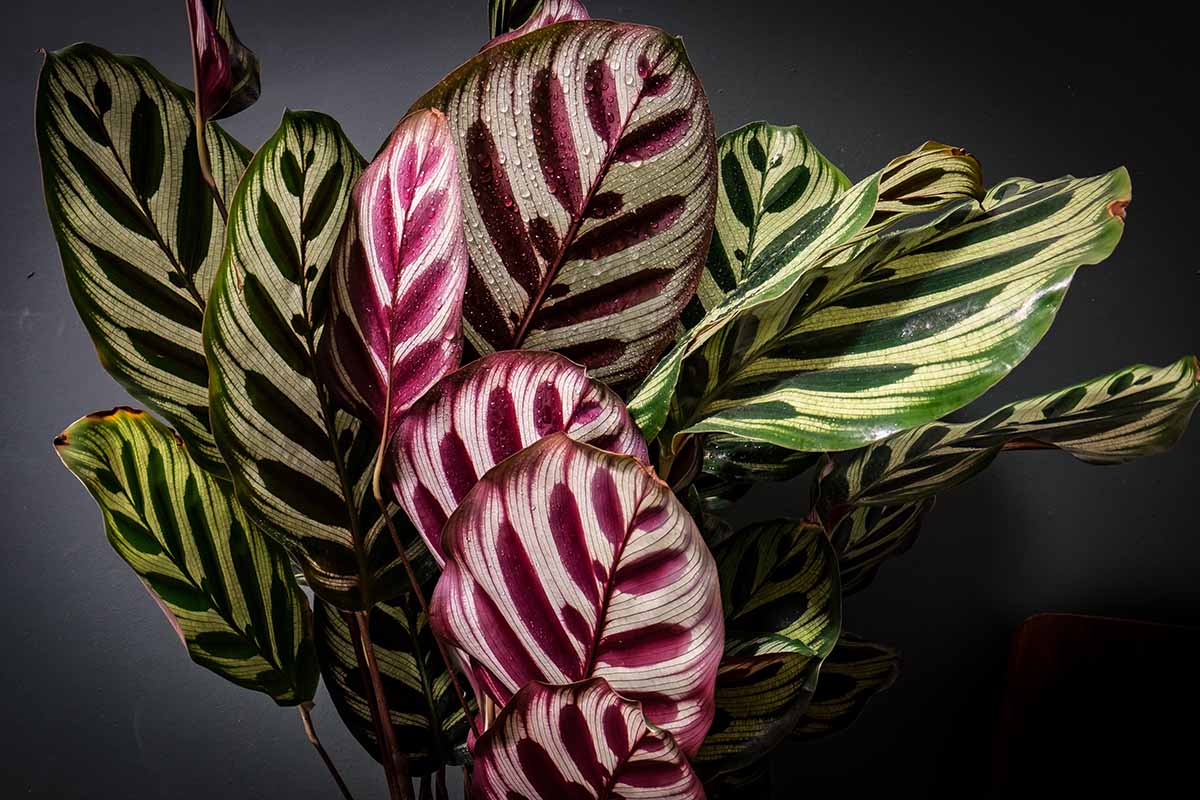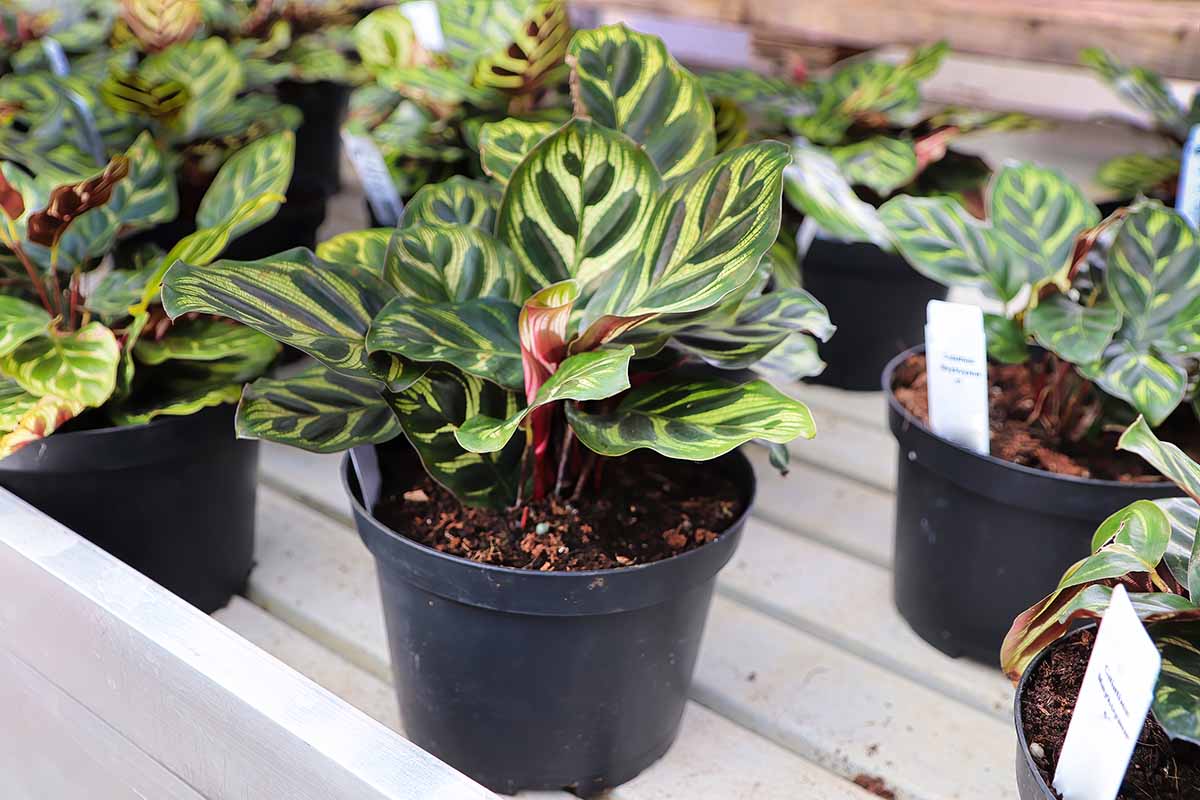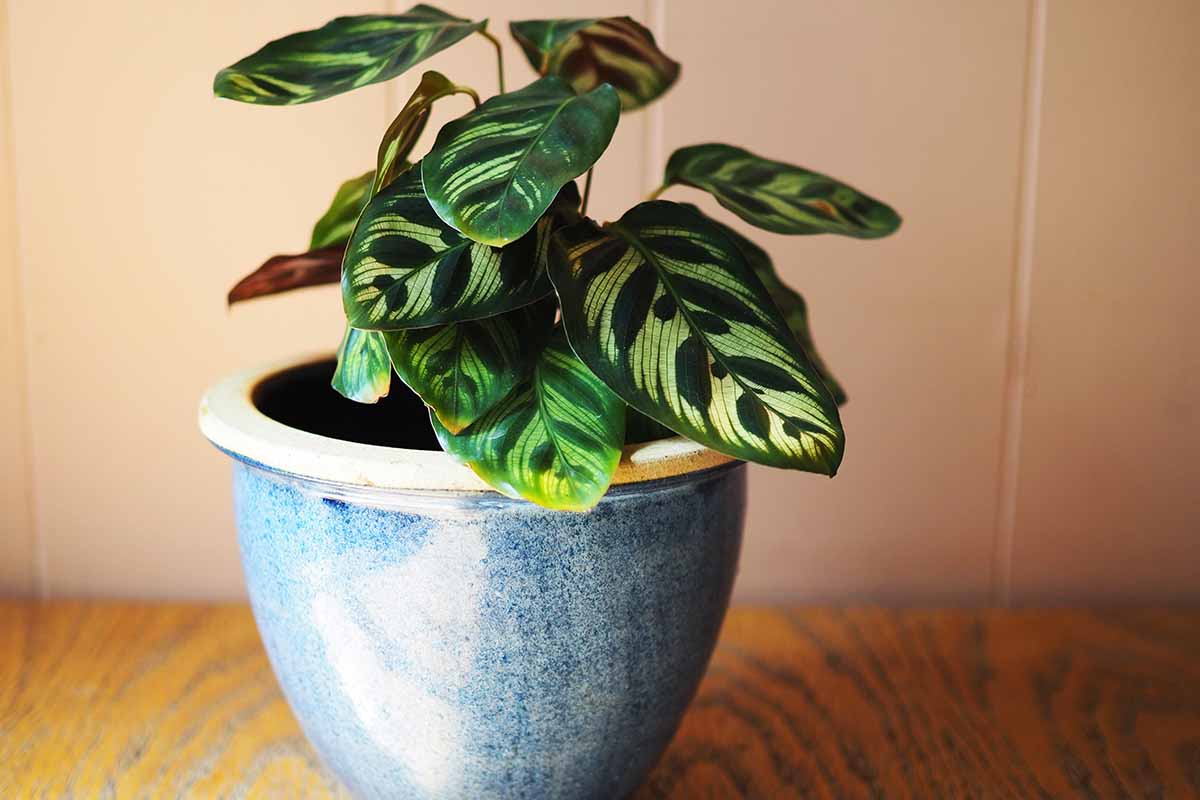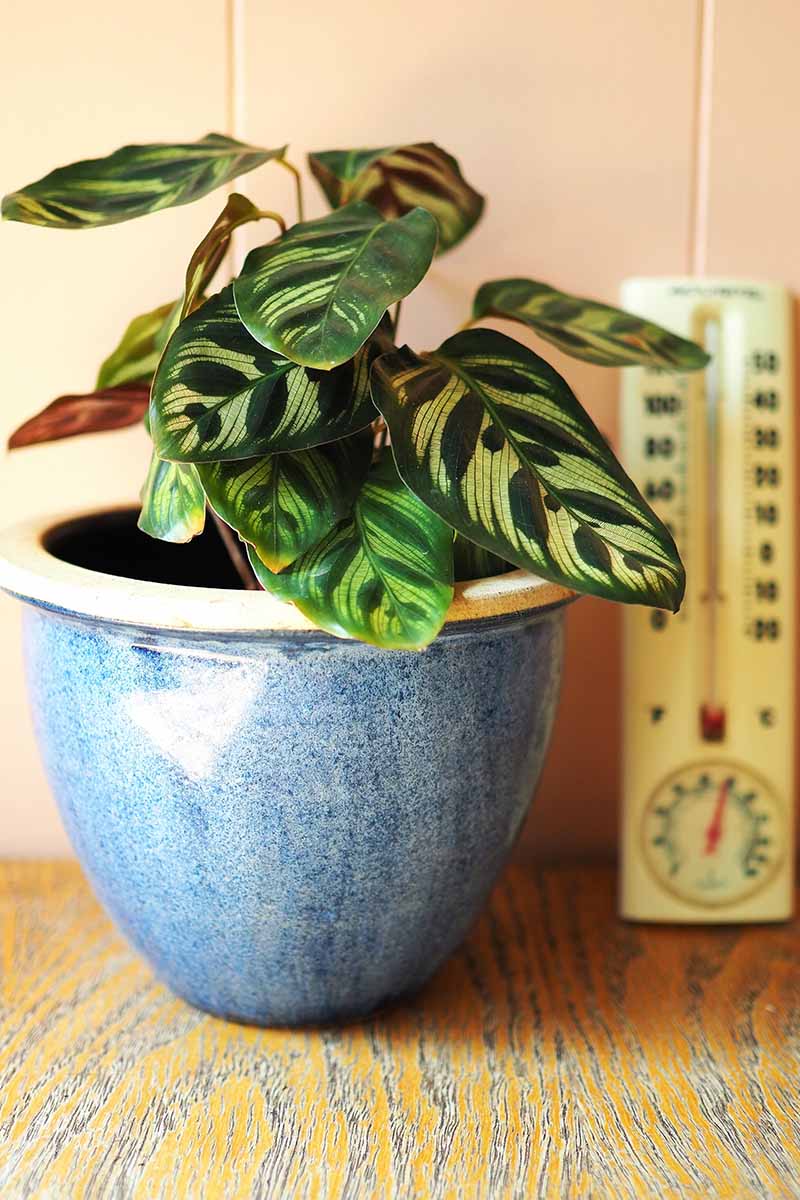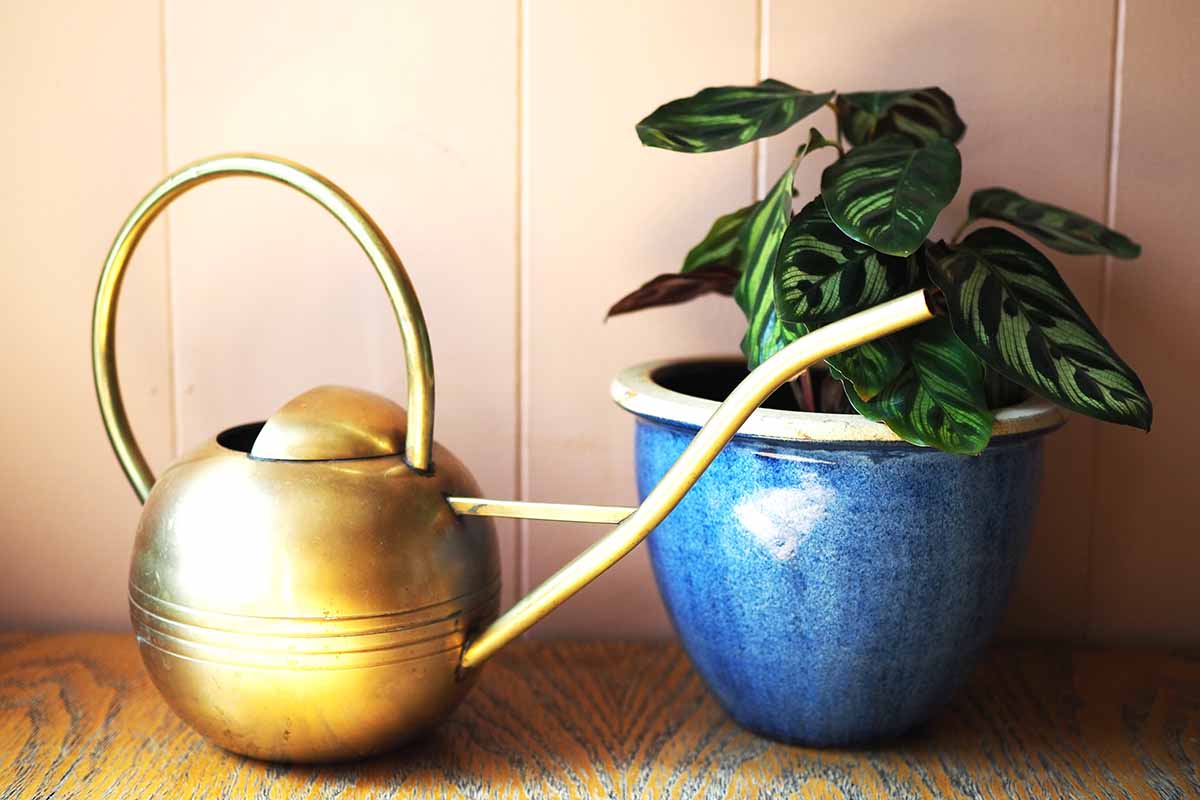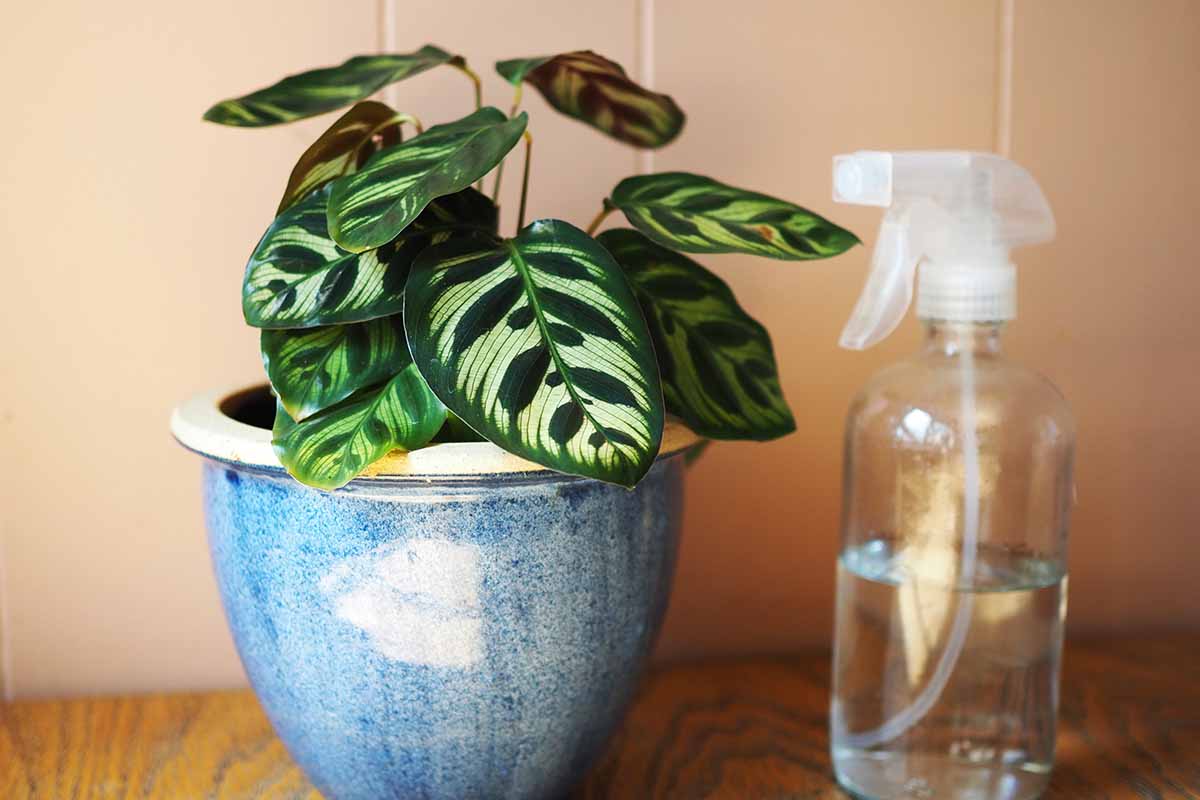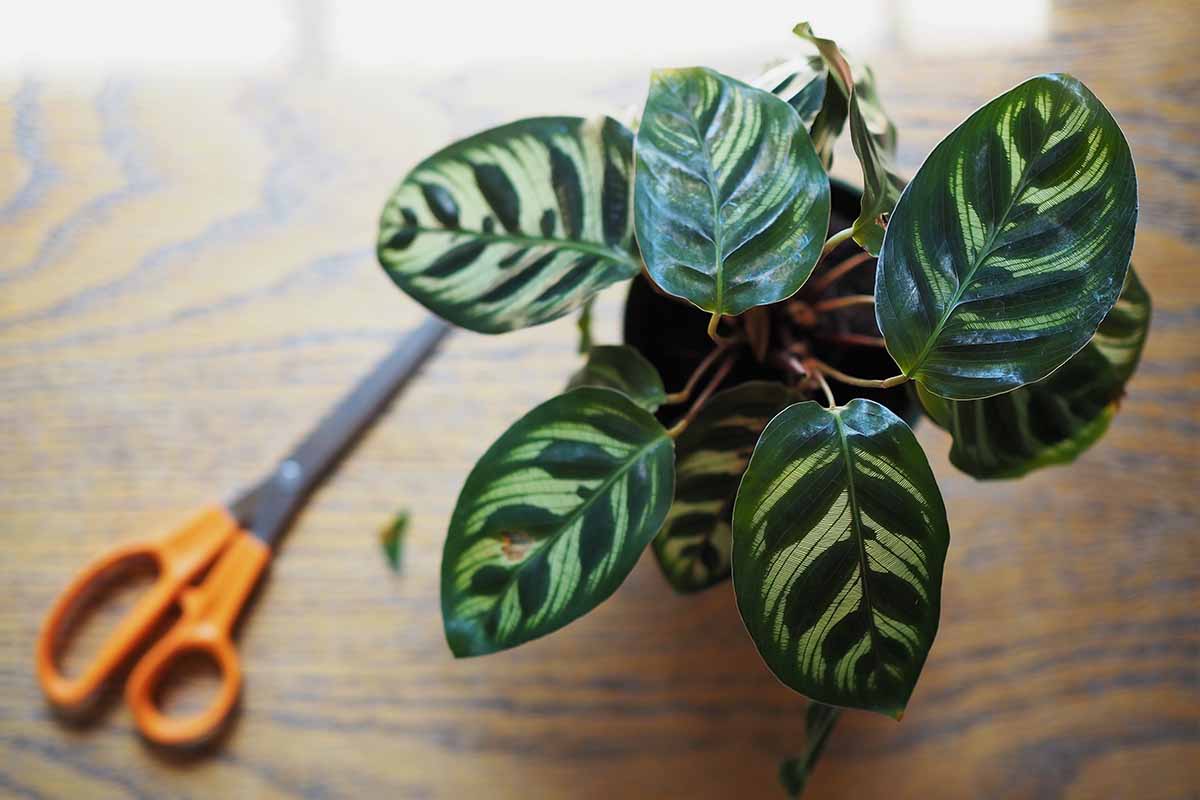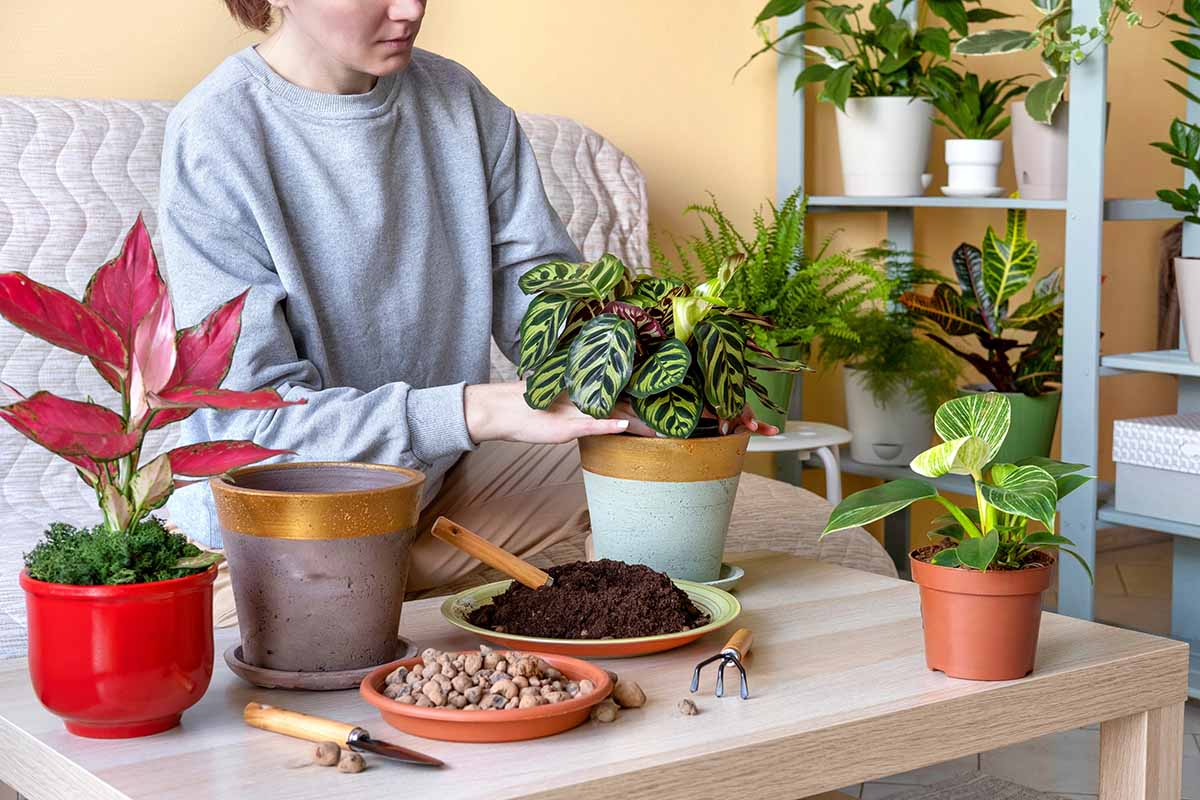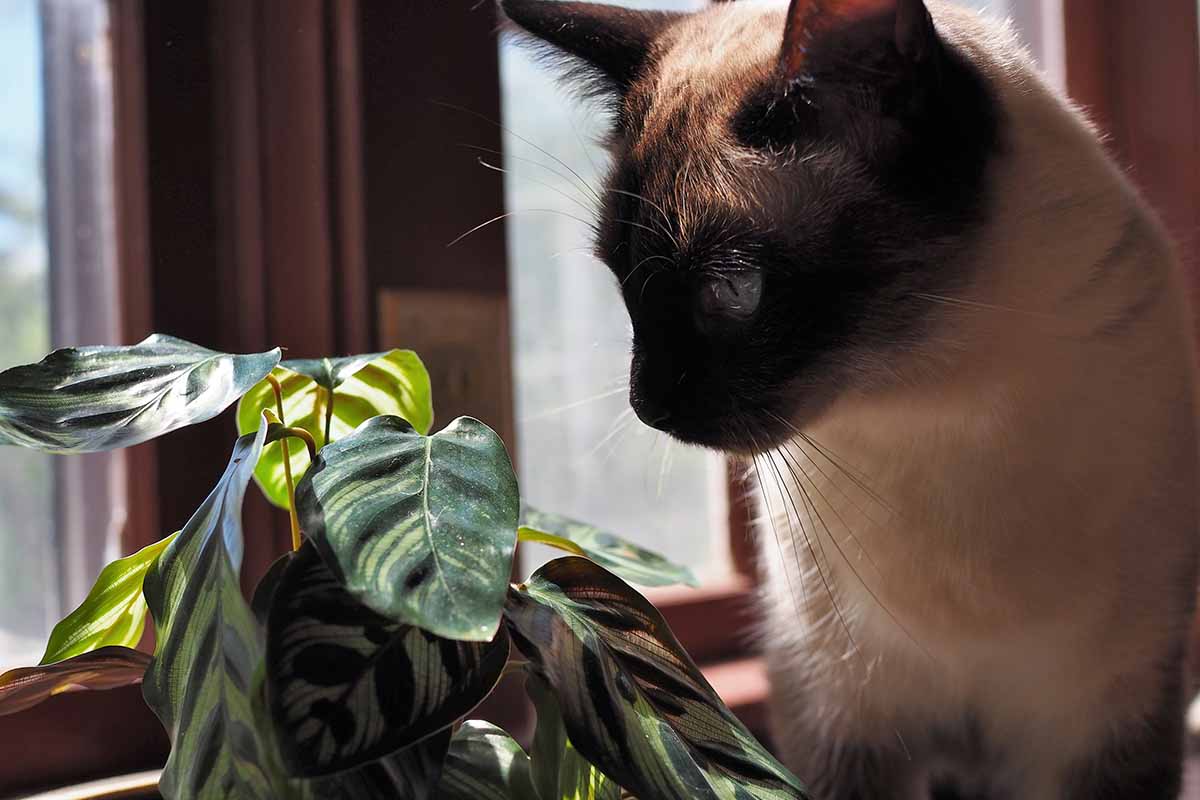We link to vendors to help you find relevant products. If you buy from one of our links, we may earn a commission. I’ll cover everything you need to know about growing and caring for peacock plant in this article. Here’s everything that’s up ahead: Before we get started, if you’re looking for more general guidance on how to grow calatheas, be sure to read our complete guide to growing and caring for prayer plants too!
What Is a Peacock Plant?
Peacock plant (G. makoyana) is an evergreen, herbaceous perennial often grown as a houseplant and loved for its fascinating leaf patterns. Each leaf is variegated with a cream or pale green background. Contrasting against this are its leaf margins, veins, and large, alternating blotches radiating from the midvein – all of which are dark green. The undersides of its leaves have the same pattern, but in purple and cream instead of light and dark green. The pattern on new leaves is lighter colored, gradually darkening as they continue to grow. The pale background of this calathea’s leaf pattern has a wispy, feather-like appearance, perhaps inspiring this species’ common name “peacock plant.” Unlike red-veined prayer plants, which have a matte leaf surface, this calathea has leaves that are glossy, and smooth leaf margins. In addition to the intriguing look of this species’ pattern, the pattern itself has a raised texture, providing even more visual interest. New leaves emerge rolled up, showing their purple sides. These slowly unfurl, revealing their green top sides. The lighter-colored parts of the leaf’s pattern are somewhat translucent, and when backlit, you can see why these calatheas are also called “cathedral windows” – the effect is similar to that of light filtering through stained glass. This calathea’s leaves are paper-thin and oval-shaped, growing to be four to eight inches long. Each leaf emerges from its own stem, rising from a clump of rhizomes in the soil. Peacock plant has a bushy, upright, spreading growth habit, reaching up to four feet tall and wide, and forming new clumps which can easily be divided. Its flowers are small, white, and inconspicuous, rarely appearing on specimens kept as houseplants. Like its other prayer plant relatives, peacock plant has a fascinating daily habit known as “nyctinastic movement.” When the sun is out, the leaves of these calatheas are held out either horizontally or at a downward angle. However, after night falls, the leaves are raised more vertically with the tips pointing upwards, revealing their purple undersides. This characteristic makes prayer plants a more interactive part of the interior than most other houseplants. And this calathea’s raised leaves can serve as a prompt to us busy humans to settle down in the evening and start to prepare for rest, if we need reminding! G. makoyana isn’t the only houseplant known as “peacock plant” – other species are sometimes (though less often) referred to with this common name too, including prayer plants G. veitchiana, and G. elliptica, potentially making communication about this species somewhat confusing. But the confusion doesn’t end there! There are other prayer plants with similar leaf patterns, which houseplant connoisseurs sometimes mistakenly identify as G. makoyana, such as yet another member of the Marantaceae family, Ctenanthe burle-marxii. C. burle-marxii is a fairly close look-alike, but compared to the subject of our article, the ends of its leaves are squared off, giving each leaf a more rectangular shape compared to G. makoyana’s oval-shaped foliage. C. burle-marxii also lacks the wide, dark green margins of peacock plant. It has a grayer background color, and more of a fishbone-style leaf pattern – which is why its common name is “fishbone calathea.”
Cultivation and History
G. makoyana is native to humid, tropical rainforests in southeastern Brazil where it grows as a terrestrial species, protected by the canopy of the rainforest from heavy rains and the full brunt of the sun. This species is a member of the Marantaceae or arrowroot family, whose members are commonly called “prayer plants.” Its relatives include the species in the Maranta, Stromanthe, and Ctenanthe genera, as well as other types of Goeppertia, which include rattlesnake plant and pinstripe plant. You might know this species as a member of the Calathea genus, the taxonomic grouping in which it was formerly classified, rather than the Goeppertia genus. But rest assured, neither of us are mistaken – it’s just that there has been some taxonomic juggling going on! In 2012, many calatheas were reclassified botanically to their current genus, Goeppertia. Now officially classified as G. makoyana, this species is nonetheless still widely referred to as C. makoyana. If you’re talking to a scientist or science geek, go ahead and throw out the Goeppertia reference and watch your conversation partner’s eyes fill with deep respect. On the other hand, if you’re looking for this species from a nursery or grower, the term “calathea” may be more likely to get you what you want! G. makoyana received the Royal Horticultural Society’s Award of Garden Merit in 1993, and while typically grown as a houseplant, it can also be grown outdoors in USDA Hardiness Zones 11 and 12.
Propagation
Calatheas are propagated primarily via division and peacock plant is no different. Since G. makoyana grows from clumps of rhizomes, these can be separated to make new specimens. When looking at your calathea, you may notice more than one clump of stems – if so, that means your specimen can easily be divided. If possible, each clump should have at least three leaves emerging from it. If you determine that your peacock plant can be divided, here’s what you’ll need: one pot per clump, big enough to contain the rhizome clump, as well as some potting medium. Remove the parent plant from its pot and gently pull apart the different clumps you want to separate. Fill in the parent plant’s pot with growing medium to fill in the gap, and pot up the divided clump or clumps. You can refer to our potting instructions, coming up a bit later in the article. Depending on how fast your specimen is growing, it can be divided about every two years, preferably in spring or early summer.
How to Grow
Peacock plants certainly don’t need you to sit and watch them all day long… unless that’s your prerogative – they are awfully pretty! But on the other hand, they are definitely not houseplants you’ll want to “set and forget.” Here’s everything you need to know:
Choosing a Plant
Your calathea-growing adventure is much more likely to be a happy one if you start off with a healthy specimen. Before choosing a peacock plant, check for signs of disease or pests, such as discolored leaves or spotting. You’ll learn more about what to look for later in the article. And if you’re purchasing a houseplant online, be sure to ask the vendor for a heat pack during the cold winter months. You may also need a cool pack during summer heatwaves for safe shipping.
Light
Rather than starting off by deciding where your calathea will look best, first look for areas in your home where this species will be able to thrive. You’ll want to situate this species in medium, indirect light, or low, indirect light. If a south-facing window is your main source of light, situate the peacock plant several feet away from the window. A bit of dappled, direct sun, such as sun filtering through deciduous trees, will be fine for your calathea, but avoid exposure to too much bright light which will make the patterns on the leaves fade, taking on a washed out appearance.
Temperature
Peacock plant will thrive in temperatures between 60 and 85°F. In temperatures hotter than this, it will struggle a bit, so you may need to reduce its light exposure from medium to low light, as well as providing it with more water to help it cope. I move my prayer plants to the north side of my un-air-conditioned home during summer, where it is significantly cooler than on the south side of my home. On the other end of the spectrum, these calatheas can be damaged by temperatures below 55°F, and can be killed by freezing temperatures, so be sure to protect this species during the winter. In addition to respecting these temperature needs, avoid placement near any cold or hot drafts of air, such as one might find near exterior doors, windows, or heat vents – G. makoyana prefers a steady temperature instead of fluctuating extremes.
Water
Proper watering is also essential to keeping your peacock plant healthy over the long term. Prayer plants tend to be sensitive to impurities in tap water, so it can be helpful to water them with rainwater, distilled water, or filtered water. Overwatering tends to be a risk for most houseplants, but that is less of a risk with this species which does not like to dry out completely. Try to keep the growing medium moist but not soggy – your plant should be watered when the surface of the growing medium is dry to the touch. However, if you let your houseplant go just a tad too long before watering it, that doesn’t mean all is lost. Give it a longer soak than usual and try to be more attentive next time. In fact, this species is a good candidate for bottom watering. You can read more about this method of watering houseplants in our article. If you struggle to keep your houseplants watered on a regular basis, here’s a tip: I find that setting alarms on my online calendar or making notes in my garden planner help me stay on target with my watering.
Humidity
Since they originate in tropical regions, peacock plants require a fair amount of humidity, specifically between 40 and 60 percent. When humidity is too low, you may notice your calathea’s leaf tips turning brown. But if your plant has brown foliage and you don’t think lack of humidity is the culprit, be sure to read our article on troubleshooting brown leaves on prayer plants. If you test your relative humidity and determine that conditions are a bit on the dry side, there are several ways you can create a more humid microclimate for your plant. Small Analog Thermometer and Humidity Gauge The relative humidity in your home may be lower at different times of the year, such as winter when heating is used, so it’s a good idea to monitor levels year-round. You may be able to simply group your peacock plant together with other houseplants to help increase humidity – but oh no, you might have to buy more prayer plants! (Ha ha!) You can also mist their leaves every morning, using the same high quality water source that you use for watering them – either rainwater, distilled water, or filtered water.
Soil
Peacock plant grows best in a well-draining potting medium that also has good water retention, and a pH of 6.1 to 7.8. A humidity tray is filled with water, then the container is placed either on rocks or a plastic grid above the water, so the plant gets the benefits of evaporating water in the air without wicking up water through the drainage holes. 10.5″ x 13.5″ Black Plastic Humidity Tray House-Shaped Glass Terrarium Finally, if you have a larger specimen, running a humidifier nearby can help. And keep in mind that you may want to employ more than one of these methods to keep your calathea happy. I grow prayer plants in an arid desert location and have excellent results combining several of these tactics – I keep mine grouped together inside mini greenhouses, with teacups full of water enclosed with them. (And in addition to holding in air moisture, the greenhouses also help protect my calatheas from my naughty cats!) If you purchase a potted calathea, it will most likely be growing in a medium containing a large amount of peat moss. But that doesn’t mean peat moss, which comes with an unfortunate ecological price tag, is the only choice for these houseplants.
Growing Tips
Provide medium, indirect light.Keep soil moist but not wet.Avoid drafts and temperature extremes.
Pruning and Maintenance
Once you have your calathea’s basic growing requirements in hand, these plants don’t require much upkeep. Here are a few simple maintenance tasks you’ll want to know about: That’s why my preferred calathea potting medium is De La Tanks Soil Mix. Quart Bag of De La Tanks Soil Mix Want to learn more about what makes a good houseplant potting soil? Read our article.
Pruning
You won’t need to prune your peacock plant to control its growth – these are pretty slow growers. However, old leaves will eventually turn brown, and if the calathea gets a bit too hot or dry at any point, you might start to notice brown tips on some of the leaves. Any discolored leaves can be trimmed off. Just use a pair of sterilized garden pruners or scissors and cut off the brown tip, or if the whole leaf has discolored, cut the stem back close to the soil line to remove the entire leaf and its stem.
Fertilizing
Prayer plants such as cathedral windows benefit from a natural, gentle approach to fertilizing. There are a few different options available, and most fertilizers designed for tropical houseplants will work. But one method preferred by many gardeners is to feed them with worm compost tea from your own worm compost system.
Repotting
Your peacock plant is not a fast grower, and will only need to be repotted once every two or three years. These sachets are soaked for several hours in room temperature water, and the infused water can be used to simultaneously water and fertilize your peacock plant. Teadrops All Purpose Houseplant Fertilizer Apply fertilizer once a month during the growing season. You’ll know it’s time to repot if your calathea starts drying out too quickly between waterings, or if you notice roots emerging from the soil surface or from the drainage holes in the base of the pot. The best time to repot is in spring when your peacock plant is putting on new growth. Choose a pot that is just one size larger than your calathea’s current pot, and make sure it has drainage holes. You’ll also need a potting medium that meets the requirements discussed in the soil section above. When you’re ready to repot, first gather your supplies. Placing some newspaper or a large baking sheet on your work surface will make cleanup easier. Grab your new pot and place a small layer of the fresh growing medium in the bottom of it. Then remove your houseplant from its current pot. Rub your hand along the root ball to loosen its roots up a bit. If your calathea is not potbound, shake some of its old growing medium loose and mix it with some of the new medium. By mixing some of the old potting medium with the new, you will encourage your plant’s roots to easily spread into the new medium. If the calathea is extremely potbound, you may not be able to free up any loose soil. In that case just focus on loosening up the roots at the outer edges of the root ball so the specimen can stretch its roots into the new medium. Place the specimen into the pot, situating it so that there is about a half an inch to an inch of space between the top of the root ball and the rim of the pot. Backfill with growing medium, tapping the pot lightly on your work surface to help the soil settle in, and adding more growing medium if needed. Water in your calathea and return it to its usual location.
Insects and Arachnids
Be sure to check newly purchased specimens for signs of pests, and if you allow these calatheas to spend time outdoors during the summer, check them again when you bring them back indoors in the fall. Here are a few options to consider, in different sizes:
Small
If your plan for your calathea is to place it in a terrarium or mini greenhouse, you will probably want to start with a petite specimen. Live Peacock Plant in 2” Pot
Medium
Specimens in four-inch pots will still fit in some terrariums and mini greenhouses, but these can also brighten up a desk or be used as part of a houseplant grouping on a table. Live Peacock Plant in 4” Pot
Large
If you’re looking for a specimen to grace an end table, a larger houseplant will make more of an impact. Live Peacock Plant in 6” Pot
Managing Pests and Disease
While peacock plant remains low maintenance in the pest and disease department, there are a few issues you might want to keep on your radar – just in case.
Mealybugs
Mealybugs are small sucking insects that look like bits of white fluff. They might look innocuous enough, but they can sicken your calatheas as they steal valuable nutrients from them. Mealybugs also leave sticky trails of honeydew in their wake, which can provide a fine opportunity for fungal organisms to set up camp as well. If you notice mealybugs on your calathea, your first step should be to isolate the specimen from your other houseplants to avoid further spread. Once that is taken care of, there are different ways you can deal with this type of infestation. My preferred treatment is to use nontoxic neem oil. Or at least it’s nontoxic to humans and pets – it is lethal to mealybugs.
Scale
Like mealybugs, scale insects are pests that will suck nutrients from your houseplants, eventually causing them to wither and die. You will probably need to repeat this treatment a few times before the pests are gone for good. 16oz Bottle of Theraneem Naturals Neem Oil Be sure to follow the manufacturer’s recommendations when applying this product – it will need to be diluted. And be sure to read our article if you’d like to learn more about controlling mealybugs. These insects can be particularly hard to spot – at first view, you may think you are seeing signs of a disease rather than pests. They latch onto stems or leaves, and look like discolored bumps. As with mealybugs, scale insects secrete honeydew as they feed on your calatheas, leading to an increased risk of fungal disease. Like the mealybug treatment mentioned above, neem oil will also take care of scale. (It’s probably sounding even better to keep a bottle at the ready, isn’t it?) There are many different types of scale insects that have different appearances – you can learn more about recognizing and controlling scale insects in our article.
Spider Mites
Spider mites are another of the most common pests to show up on calatheas, and they can infest calatheas like cathedral windows if given the opportunity. Look for signs of stippled leaves – foliage with many tiny, discolored spots. Turn the leaves over and you might find extremely small, red dots on the leaf undersides – those are the spider mites – and if the infestation is severe, you may also see webbing. In calatheas, spider mites are more of a risk if the plants are exposed to too much sun, so make sure to provide your calathea with the right amount of light. You can learn more about detecting and controlling spider mites in our article.
Disease
Disease tends to be fairly infrequent in calatheas kept as houseplants, but if your plant looks out of sorts, here are some common plant diseases you’ll want to rule out:
Cucumber Mosaic Virus
As its name suggests, cucumber mosaic virus, similar to turnip mosaic virus, creates a strange yellow pattern on the leaves of infected calatheas that may look similar to a mosaic. In addition to the telltale mosaic pattern, other signs of this disease can include yellowing veins, stunted growth, deformed leaves, and yellow spots on foliage. Unfortunately, there is no remedy for this plant illness, so prevention is imperative. Be sure to sterilize tools and wash your hands before handling different specimens. And while damage may only be cosmetic, this disease can be spread from plant to plant through insects such as aphids, so the best recourse is to dispose of infected specimens.
Helminthosporium Leaf Spot
Have you noticed brown or tan lesions surrounded by a yellow halo on the foliage of your calathea? If so, Helminthosporium leaf spot may be to blame. This disease is caused by fungal organisms such as Bipolaris and Drechslera species, and is a risk when temperatures are mild in damp conditions. To prevent this disease, only mist the leaves of your calathea on sunny days and only in the morning, providing it plenty of time to dry before night falls and temperatures cool. In order to manage an existing infection, use nontoxic neem oil. The same product you can use to control pest infections of spider mites, scale, and mealybugs is also a fungicide.
Root Rot
Is your calathea wilting despite having wet soil? That’s a strong sign that root rot is to blame. Root rot is probably the disease you are most likely to encounter in your houseplants, but on the positive side, this is easy to prevent. Another potential sign of this illness is wilting, yellow leaves. This disease usually occurs when calatheas are overwatered, or if drainage is insufficient. Plant roots can rot if they lack oxygen, and their inability to function deprives the plants of the water they need to survive. Meanwhile, pathogenic organisms such as fungi and water molds can proliferate in the soggy conditions. It can be hard to bring a plant back from root rot, so the best recourse is prevention – make sure the plant is potted in the right sized pot and in a well-draining growing medium. Also, be sure there are drainage holes in your calathea’s pot, and never let it sit in a saucer of water for extended periods of time. If your specimen has fallen victim to root rot and you’d like to try to save it, first identify the problem so that it doesn’t reoccur. You may need to repot into a smaller container, switch to a pot with more drainage holes, or just go a little easier on the watering. Remove your calathea from its pot and inspect its roots. They should be firm – if they are mushy, they are rotting. Trim back any rotting roots and repot the plant into a new pot (smaller, if necessary) with fresh growing medium. Water the plant just enough for liquid to run out of the drainage holes. If you’re dealing with yellow leaves on your calathea but root rot doesn’t seem like it’s to blame, read our article about troubleshooting yellow leaves on prayer plants.
Best Uses
With good care and maintenance, you can put your peacock plant to many different uses. This species is an excellent foliage plant, and with its upright, bushy growth habit, it can bring its good looks to your favorite pot or planter. If you’re interested in creating a grouping of houseplants, this calathea can be arranged with other species such as orchids or begonias. And while G. makoyana will grow best in medium light, it can also be used as a low-light houseplant.
Quick Reference Growing Guide
Strut Your Peacock’s Stuff
With just a little care, your peacock plants will be so gorgeous your eyes will be riveted to their leaves. Just remember to provide medium, indirect light, a water-retentive but well-draining potting medium, and a little extra humidity. Would you like a chance to strut your peacock’s stuff? Feel free to share your calathea’s story and photos in the comments section below. Need help troubleshooting a problem with your calathea? That’s fine too, we’re happy to help! And if you’d like to explore even more varieties of beautiful prayer plants, get ready to dive right in to the gorgeous foliage, right here:
21 of the Most Stunning Species of Prayer Plants to Grow at HomeHow to Grow Stromanthe Triostar HouseplantsWorth Its Stripes: How to Grow and Care for Calathea Zebrina Plants
